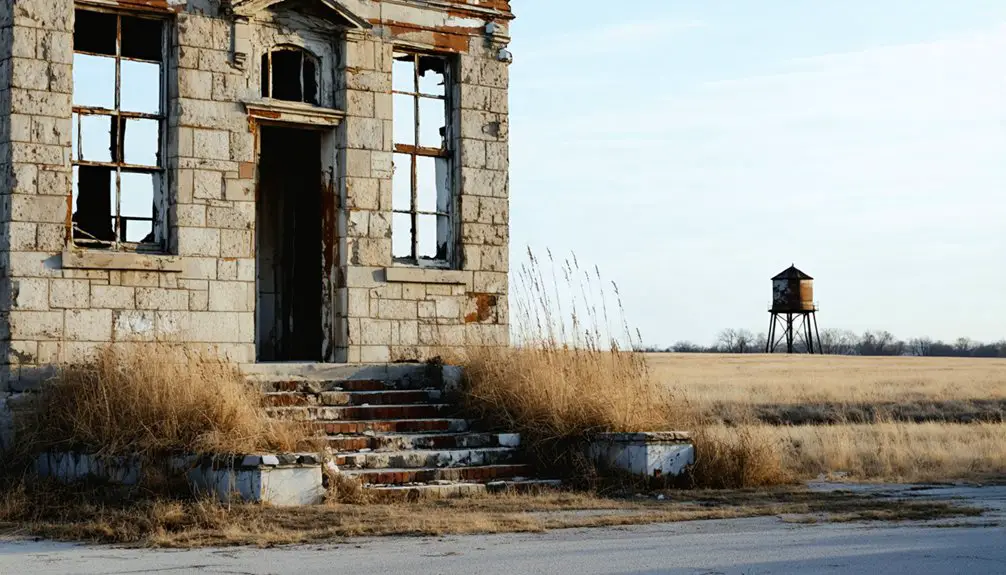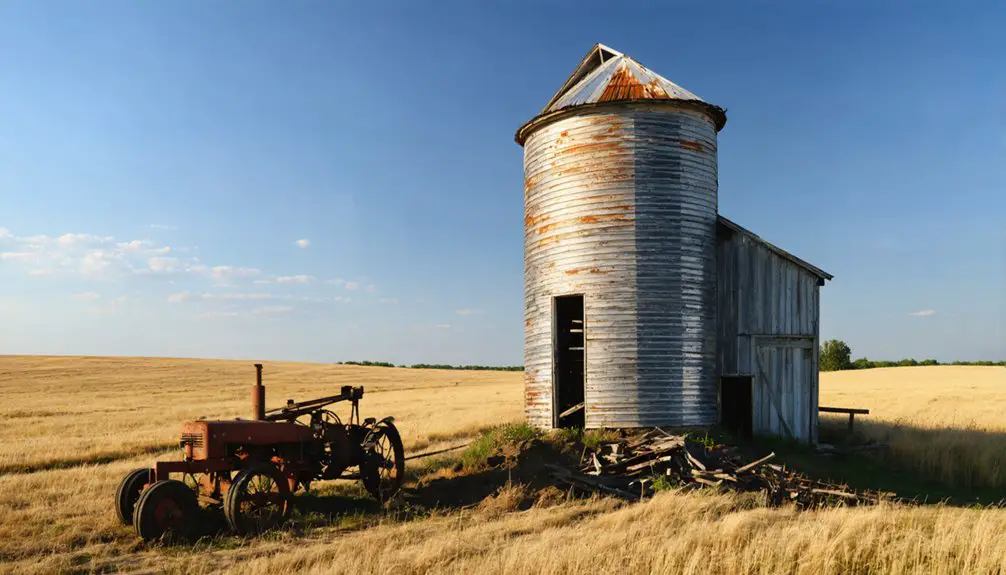You’ll find Oxford, Kansas’s haunting transformation etched in its abandoned streets and overgrown pathways. Founded in 1857 during the “Bleeding Kansas” conflict, this frontier settlement flourished with railroads, a historic mill, and essential commerce along the Santa Fe Trail. After an infamous election fraud that helped spark the Civil War, Oxford boomed until the late 1800s before declining. Today, nature reclaims the town while preservation efforts keep its complex story alive.
Key Takeaways
- Founded in 1871 by the Oxford Town and Immigration Company, the town flourished initially with rapid development of stores, post offices and railroads.
- The historic Oxford Mill, established in 1874, served as the town’s economic center until its eventual abandonment and decline.
- Multiple railroad lines supported the town’s growth until the late 1800s, but their removal contributed significantly to Oxford’s transformation into a ghost town.
- Former streets have been reclaimed by prairie grasses and wildlife, with only street signs remaining as remnants of the once-bustling community.
- Community preservation efforts in the 1980s, led by local champions, attempted to save historical structures including the Old Mill and Presbyterian church.
The Rise and Fall of a Frontier Settlement
When the Oxford Town and Immigration Company laid out their ambitious plans in January 1871, they couldn’t have known their settlement would embody the quintessential American frontier story of boom and bust.
You can trace their early optimism through rapid developments: the first store opened in March, followed by a post office in April, and a sawmill in May.
Railroad expansion in the late 1870s fueled Oxford’s growth, with three major lines converging on the town by 1887. The Missouri Pacific Railroad arrived that same year, strengthening the town’s transportation network.
The Oxford Mill became the heart of local commerce in 1874, helping the settlement incorporate as a third-class city with 263 residents.
The bustling Oxford Mill transformed a frontier outpost into an official city, cementing its role as the community’s economic anchor.
But economic challenges would eventually take their toll – railroads were removed, the mill was abandoned, and the town’s liveliness faded into memory. The town’s decline accelerated when many residents joined the Confederate Army during the Civil War.
Roots in the Bleeding Kansas Conflict
While most frontier towns emerged from railroad expansion or mineral strikes, Oxford’s story began in the violent crucible of Bleeding Kansas in 1857. Pro-slavery settler Christopher Columbus Catron founded the settlement near the Missouri border, positioning it as a stronghold during the territory’s bitter struggle over slavery. Free State settlers organized military units to defend against the increasing pro-slavery aggression.
You’ll find Oxford’s darkest chapter in the notorious 1857 election fraud, where pro-slavery supporters manufactured over 1,600 votes from a mere 90 legal voters. They’d copied names straight from an Ohio directory to sway territorial politics.
The town became a flashpoint for pro-slavery tensions as Missouri “border ruffians” crossed frequently to intimidate free-state settlers. Oxford’s strategic location made it central to the guerrilla warfare and political violence that would eventually help spark the Civil War. The violence escalated dramatically after John Brown’s raids ignited retaliatory attacks from both sides of the conflict.
Legacy of the Oxford Election Fraud
The fraudulent Oxford Township election of 1857 reverberated far beyond Kansas Territory’s borders, fundamentally altering the nation’s political landscape.
When you examine this brazen case of political manipulation, you’ll find that election integrity stood at the heart of America’s struggle over slavery.
- Governor Walker’s courageous rejection of 1,628 fraudulent votes exposed the desperate tactics of pro-slavery forces.
- The scandal’s exposure helped propel the Free State movement to its first major victory.
- Southern Democrats’ fierce reaction to the vote’s annulment deepened the growing national divide.
- You can trace a direct line from Oxford’s election fraud to the intensifying sectional conflicts that sparked the Civil War.
With only forty eligible voters residing in Oxford, Johnson County, the submission of over 1,600 votes raised immediate suspicion.
Investigation revealed that the fraudulent names were copied from a Cincinnati city directory to create the appearance of legitimate voters.
This pivotal moment in Kansas history reminds us that protecting the sanctity of the ballot box shapes our nation’s destiny.
Life Along the Santa Fe Trail
Beyond the heated political battles of territorial Kansas lay a different kind of frontier drama – life along the Santa Fe Trail.
You’d find a bustling corridor of trail commerce stretching nearly 900 miles from Missouri to New Mexico, where traders braved an eight-week journey through Comanche territory. At stops like Diamond Spring and Pawnee Rock, you’d witness cultural exchanges between American merchants, Mexican traders, and Indigenous peoples.
The trail’s significance peaked before 1880, as caravans hauled manufactured goods westward and returned with precious metals and furs. William Becknell became known as the father of the trail when he pioneered the route in 1821. Travelers paid a hefty stagecoach fare of $250 to make the journey starting in 1849.
You’d see military escorts protecting ox-drawn wagons from 1829 onward, while trading posts and forts like Fort Leavenworth offered refuge.
This international highway transformed the region until the railroad’s arrival, forever altering the lives of traders, adventurers, and Native Americans who called these lands home.
The Historic Oxford Mill Through Time
Standing as a demonstration to pioneer ingenuity, Oxford’s historic mill first churned to life in 1874 through remarkable community cooperation.
You’ll find the three-story stone structure nestled in a wooded valley, where local volunteers carved out a half-mile diversion channel from the Arkansas River, while neighbors donated stone for its construction. The mill was later acquired by Charles Champeny who dedicated his life to its operation.
The mill’s technology evolved with America’s progress, shifting from burr grinders to steel rollers in the 1880s. By this time, flour milling had become Kansas’s largest industry.
Here’s what made this mill a symbol of frontier independence:
- Your ancestors worked day and night, grinding wheat into the renowned “Oxford’s Best” flour
- During the Great Depression, you could trade wheat on shares, getting 34 pounds of flour per bushel
- Community support kept the mill running for nearly 100 years
- The mill powered the region’s growth until 1973, attracting farmers from 200 miles away
From Bustling Streets to Overgrown Paths
If you visit Oxford’s location today, you’ll find only faint traces of what was once a bustling trade center, with former streets like Oak Road now completely overtaken by grass and brush.
You can still make out some of the original street grid through satellite imagery, though the actual ground has reverted to natural terrain.
Where merchants and townspeople once walked along active thoroughfares, only empty fields and scattered ruins remain to mark the ghost town‘s former urban layout.
Lost Urban Grid
When Oxford, Kansas first emerged in 1857, its methodically planned grid system embodied the ambitious vision of its frontier founders.
Today, as you walk through what remains, you’ll find only fragments of that once-precise urban layout, now succumbing to nature’s reclamation. Historical mapping reveals the stark reality of urban decay, where vibrant streets have faded into mere memories.
- Oak Road’s weathered street sign stands as a lonely sentinel, guarding a pathway now swallowed by prairie grass.
- Former bustling intersections lie silent, their corners marked only by ghost traces of commerce.
- Railroad tracks that once brought life to the town now rust quietly among encroaching vegetation.
- Historic buildings, including the old mill, stand as crumbling witnesses to the grid’s slow dissolution.
Nature Reclaims Streets
The relentless march of nature has transformed Oxford’s once-bustling streets into wild pathways, where prairie grasses wave in the Kansas wind.
You’ll find street signs standing as lonely sentinels among the vegetation, marking roads that now exist only in memory. Nature’s reclamation is particularly visible during summer months, when abundant plant growth further obscures the town’s former grid.
If you venture through these forgotten thoroughfares today, you’ll witness how seasonal floods, rain, and wind have eroded the old infrastructure, creating perfect conditions for native plants to take root.
The process of urban decay continues unabated – without human maintenance to hold it back, the environment steadily reclaims what was once paved and orderly, turning Oxford’s streets into natural corridors where wildlife now freely roams.
Landmarks and Lost Infrastructure

Once bustling with industrial activity, Oxford’s landmarks tell a bittersweet tale of decline and lost infrastructure. The iconic Oxford Mill, built in 1874 with sturdy Mount Chetopa stone, stands as a monument to the town’s former industrial might.
You’ll find historic preservation efforts couldn’t save this flour mill from infrastructure decay, despite its brief revival as a restaurant in the early 2000s.
- The mill’s 3-mile water race, once channeling Aranansas River power, now lies silent and forgotten.
- Ghost streets with standing signs lead to nowhere, marking paths where vibrant roads once existed.
- The old quarry at Mount Chetopa bears silent witness to both industrial ambition and failure.
- One-room schoolhouses and earthen mounds remain as sole witnesses to lost civic pride.
Preserving Oxford’s Complex Heritage
Preserving Oxford’s rich historical tapestry has become a community-driven mission since the 1980s, with local champions like Wallace Champeny and Hal Ross leading vital restoration projects.
You’ll find the cultural significance of Oxford deeply rooted in its Osage heritage, when Chief Napawalla’s people called this land home before the 1870 treaty changed everything.
The town’s preservation efforts showcase remarkable community involvement, from the 1989 restoration of the Old Mill to the protection of the first Presbyterian church south of the Arkansas River.
You can trace Oxford’s educational legacy to the 1870s when it established Sumner County’s first school district.
While the Old Mill’s preservation has faced economic challenges, you’ll witness how dedicated locals continue fighting to maintain these important landmarks, ensuring Oxford’s complex heritage endures for future generations.
Frequently Asked Questions
What Happened to Oxford’s Original Native American Inhabitants After Settlement?
You’ll find the Osage people faced cultural displacement, relocating to Oklahoma after the 1870 Treaty forced them from their ancestral lands, leaving a lasting historical impact on their community’s traditions.
How Did Local Families Survive the Harsh Winters in Dugout Homes?
You’d endure -20°F winters thanks to dugout insulation’s natural 55°F baseline temperature. You’d store dried meats and root vegetables, relying on earth-sheltered walls and community support for winter foodways survival.
Were There Any Notable Crimes or Outlaws in Oxford’s Early Days?
While you won’t find notable outlaws specific to Oxford’s streets, the town’s early crimes centered on political violence and election fraud during Bleeding Kansas’ pro-slavery conflicts in 1857.
What Types of Businesses Existed in Oxford Besides the Mill?
In a bustling sea of commerce, you’d find everything from a general store and blacksmith shop to hotels, restaurants, banks, a newspaper office, and retail shops serving daily needs.
Did Oxford Have Any Schools or Educational Institutions During Its Peak?
You’ll find Oxford’s rich educational facilities included the pioneering one-room schoolhouse from 1871, the historic Oxford School built in 1877, and a high school that opened in 1929.
References
- https://legendsofkansas.com/oxford-kansas-johnson-county/
- https://crimereads.com/the-ghosts-of-oxford-a-love-letter-to-a-haunted-city/
- https://legendsofkansas.com/oxford-kansas/
- https://www.youtube.com/watch?v=OyBXD18P_j4
- https://www.jocohistory.org/digital/custom/oxford
- https://oxfordks.org/important-historical-dates
- https://www.humanitieskansas.org/get-involved/kansas-stories/places/mining-for-stories-in-a-kansas-ghost-town
- https://en.wikipedia.org/wiki/Bleeding_Kansas
- https://www.essentialcivilwarcurriculum.com/bleeding-kansas.html
- https://scholarship.law.wm.edu/cgi/viewcontent.cgi?article=2110&context=wmborj



